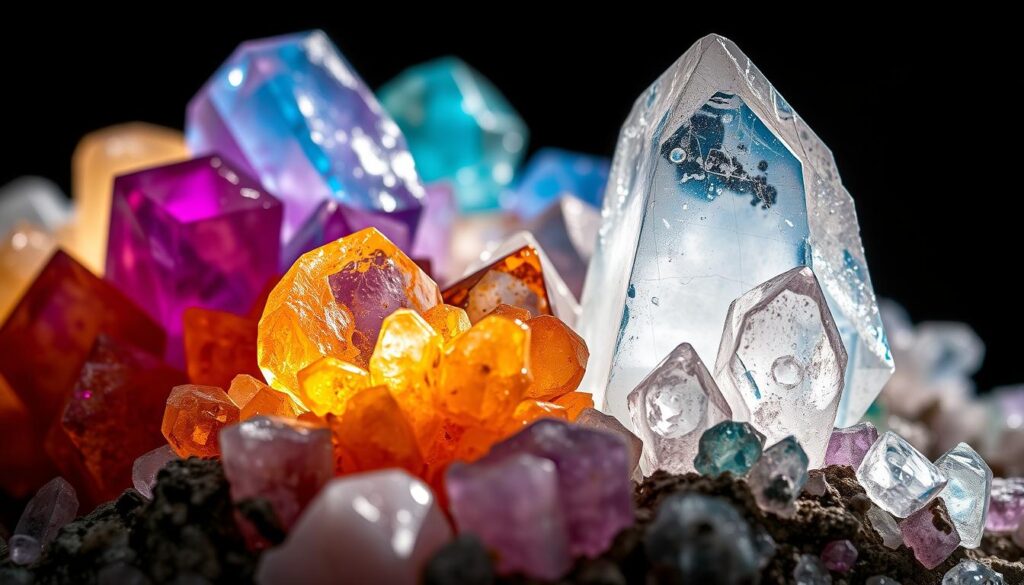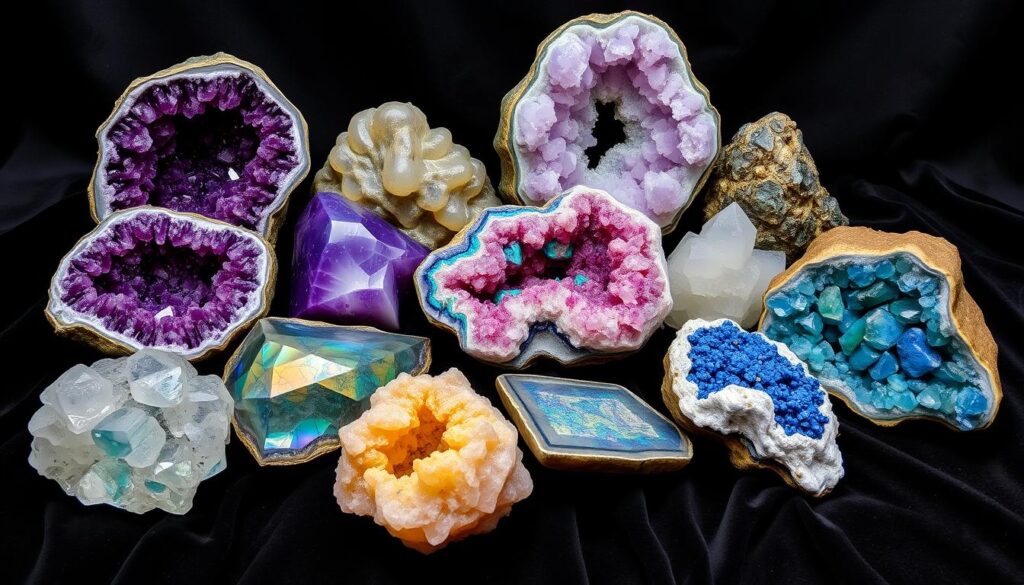This post contains affiliate links.
Have you ever wondered what treasures lie beneath the Earth? The world of mineral specimens is full of natural wonders. These wonders, from crystals to gemstones, have amazed collectors for centuries.
Imagine holding a piece of history. A large silver specimen from Germany or a stunning emerald from Colombia. These aren’t just rocks; they’re windows into the Earth’s past, formed over millions of years.
For those new to mineralogy, starting a rock collection is exciting. You’ll find unique formations like stellerite and Ethiopian opals. These have textures and colors that seem magical.
Whether you’re interested in their value or beauty, mineral specimens have something for everyone. From affordable pieces for beginners to rare, high-value ones, there’s a wide range to explore.
Key Takeaways
- Mineral specimens offer a unique blend of natural beauty and geological history
- Famous mining locations like Muzo Mine and Panasqueira Mine produce exceptional specimens
- Specimens range from affordable options for beginners to rare, high-value pieces
- Factors like rarity, size, color, and quality determine a specimen’s value
- Proper care and cleaning are essential to maintain a specimen’s beauty and worth
Understanding the World of Mineral Specimens
Mineral specimens reveal Earth’s hidden treasures. They are inorganic elements found in the Earth’s crust, forming rocks. With over 4,900 known mineral species, collecting minerals is vast and captivating.
What Defines a Mineral Specimen
Mineral specimens are raw samples from the earth, valued for their unique chemical structures and looks. They can have one or more mineral types, each with its own crystalline formation. Collectors and enthusiasts love these specimens for their scientific value and beauty.
https://www.youtube.com/watch?v=bId35hOCOwA
Historical Evolution of Mineral Collecting
The love for minerals has a long history. Ancient civilizations used gemstones for decoration, while the Victorian era focused on their scientific study. Today, mineral collecting is booming, thanks to wealth in Asia and new mining in South America, China, and Pakistan.
Modern Collecting Practices
Today, mineral collecting is a mix of science and art. Collectors look for specimens with unique shapes, colors, and rarity. These specimens can make stunning displays, adding luxury to any room. You can find amazing pieces at famous mineral shows in Denver, Munich, and Tucson, where rockhounding enthusiasts come to admire and buy these natural wonders.
| Mineral Property | Description | Example |
|---|---|---|
| Composition | Single or multiple elements | Gold (single), Quartz (multiple) |
| Structure | Crystalline arrangement | Cubic, Hexagonal, Monoclinic |
| Appearance | Color, luster, streak | Ruby (red), Diamond (brilliant) |
| Hardness | Resistance to scratching | Talc (1), Diamond (10) |
Whether you’re drawn to gemstones or the complex structures of fossils, mineral collecting is a fascinating journey. It connects you with the Earth’s geological wonders. From lapidary arts to studying rocks, this hobby lets you explore the planet’s rich mineral heritage.
The Value and Investment Potential of Fine Minerals
Fine mineral specimens are a unique investment in geology. They grow in value at about 7% each year. This means their worth can double every ten years. This growth rate is higher than many other investments, making them a good choice for diversifying your portfolio.
When you invest in minerals, choose carefully. High-quality pieces from famous places are more valuable than random ones. Look for minerals with stunning crystal formations, bright colors, and beauty.
“Buying minerals is not just about aesthetics; it’s about understanding their geological significance and rarity.”
The market for minerals can change a lot. Prices go up and down with new finds, mine closures, and what collectors want. To make smart choices, keep up with trends and track your purchases. This helps you see the value of new finds.
| Investment Aspect | Mineral Specimens | Traditional Investments |
|---|---|---|
| Average Annual Appreciation | 7% | Varies (e.g., S&P 500: 10%) |
| Liquidity | Lower | Higher |
| Market Volatility | Moderate | High |
| Tangible Asset | Yes | Often No |
While there’s a chance to make money, remember to love collecting minerals. The joy of owning these wonders is often more valuable than their price. As you grow your collection, enjoy the minerals and their investment potential for a fulfilling experience.
Essential Characteristics of Premium Specimens
Premium mineral specimens capture the hearts of collectors with their unique qualities. In the world of mineralogy, these treasures stand out for their exceptional features. Let’s explore what makes a specimen truly remarkable.
Crystal Formation and Structure
The way crystals form and grow impacts their value. Collectors seek specimens with well-defined shapes and sharp edges. For example, quartz often forms stunning hexagonal prisms due to its atomic structure.
Color and Transparency
Vibrant colors and clarity are prized in gemstones and minerals. The deep green of emeralds or the fire of opals can make specimens highly desirable. Transparency adds depth, allowing light to dance through the crystal.

Size and Presentation
Larger specimens often command higher prices, but size isn’t everything. The way a mineral is presented can enhance its appeal. A perfectly positioned crystal cluster on matrix rock can be breathtaking.
Rarity and Uniqueness
Rare minerals or unusual formations can make a specimen invaluable. Collectors treasure pieces that are one-of-a-kind or from famous localities. Some enthusiasts even embark on rock hounding adventures to find their own unique treasures.
| Characteristic | Impact on Value | Example |
|---|---|---|
| Crystal Formation | High | Perfect quartz hexagons |
| Color | Very High | Deep blue sapphires |
| Transparency | High | Clear topaz crystals |
| Size | Moderate to High | Large amethyst geodes |
| Rarity | Very High | Benitoite from California |
Understanding these characteristics helps collectors appreciate the beauty and value of their specimens. Whether you’re drawn to the sparkle of gemstones or the intricate patterns in petrography, each piece tells a unique story of Earth’s geological marvels.
Famous Mining Locations Around the Globe
The world of geology is full of treasures waiting to be found. Let’s look at some famous mining spots that have amazed both collectors and scientists.
Minas Gerais in Brazil is a dream come true for gem lovers. It’s home to many quartz types, like amethyst, citrine, and rose quartz. The area is rich with hundreds of minerals, each one unique.
The Franklin and Sterling Hill mines in New Jersey, USA, are truly special. They have over 350 known minerals, including rare crystals. These mines have given us some of the world’s most beautiful minerals, making them a top spot for collectors.
In England, the Cornwall and Devon mining areas are also famous. They have over 300 different minerals. These places are still a hit with geologists and mineral fans because of their wide variety of specimens.
| Location | Notable Minerals | Unique Features |
|---|---|---|
| Minas Gerais, Brazil | Amethyst, Citrine, Rose Quartz | Hundreds of mineral varieties |
| Franklin & Sterling Hill, USA | Franklinite, Willemite, Zincite | 80+ fluorescent minerals |
| Cornwall & Devon, England | Over 300 species | Historic mining region |
The Langban Mine in Sweden is a gem for those seeking rare minerals. It has nearly 100 unique minerals, including silicates, arsenates, oxides, and phosphates. It’s a key place for finding new minerals.
These famous mining spots are full of opportunities for collectors and scientists. Each place has its own story of how our planet’s minerals were formed. They show the incredible variety of our planet’s treasures.
Rare and Exceptional Mineral Specimens
The world of mineral specimens is full of treasures that catch the eye. From museum-quality pieces to historic finds, these gems show us Earth’s wonders.
Museum-Grade Examples
Museum-grade mineral specimens are the jewels of any collection. They show nature’s art at its best. The Cerussite from Arizona’s Grand Reef Mine is a standout, priced at $4,500. Its beauty and rarity make it a must-have for serious collectors.

Historic Discoveries
Historic mineral finds have shaped the field. In the Victorian era, European royals competed to collect the finest specimens. This craze still influences today’s market. Places like Pakistan, Afghanistan, Brazil, and Morocco are hotspots for collectors.
Record-Breaking Specimens
Record-breaking minerals are known for their size, color, or crystal shape. These unique pieces can command high prices. The market for minerals is booming, with collectors in Asia and Europe leading the way.
| Category | Details |
|---|---|
| Average Price | $1,772.22 |
| Highest Priced Specimen | Cerussite from Grand Reef Mine, Arizona ($4,500) |
| Lowest Priced Specimen | Selenite with Kobyashevite from Ojuela Mine, Mexico ($200) |
| Most Common Size | Miniature (14 specimens) |
| Top Country of Origin | United States (6 specimens) |
Collecting rare minerals is a captivating journey. Whether you’re interested in crystals, fossils, or unique gems, each piece has a story. Start your collection today and discover the wonders of these natural treasures.
Starting Your Mineral Collection
Exploring rocks, gems, and crystals is thrilling. Your journey starts with picking out specimens and learning about their special qualities. Begin with small, affordable pieces to find what you like.
Think about these things when choosing specimens:
- Visual appeal
- Scientific interest
- Potential investment value
Look for trusted dealers and online shops for real pieces. Going to mineral shows and joining groups can teach you a lot. You’ll find unique rocks and gems.
It’s important to keep a catalog of your collection. Note the mineral name, where it’s from, when it was found, and how much you paid for it. Joe Cilen, a serious collector, cataloged 23,000 minerals with their original labels.
Join local mineral clubs for learning and field trips. These groups are great for meeting others and seeing their collections. But, remember to display your pieces well. Don’t collect more than you can show off.
“Keep labels with mineral specimens to identify locality and rarity. Without proper documentation, accurate identification becomes challenging.” – John Betts, Mineral Expert
Get a good book on minerals to help you learn. As your collection grows, you might focus on certain crystals or formations. Enjoy your journey!
Proper Care and Preservation Techniques
Caring for your mineral specimens, rocks, gems, and crystals is important. You need to clean, store, and display them carefully. These items are precious and need special care to keep their beauty and value.
Cleaning Methods
When cleaning your minerals, use lukewarm water and soft brushes. Be gentle with sensitive minerals. For harder dirt, try soaking or use special cleaning solutions.
Stones with a Mohs hardness of 6 or above can usually be cleaned with water.
Storage Solutions
Store your rocks and gems in a safe place to prevent damage. Use containers made of stainless steel, wood, or plastic. For dangerous minerals like asbestos or cinnabar, use polyethylene self-sealing bags.
Keep the humidity level below 60% to stop pyrite decay in certain specimens.
Display Options
Show your crystals in glass cases or natural decor. Larger pieces need strong shelves or stands. Be careful with sunlight – some stones like blue calcite can become brittle.
Quartz spheres can act as magnifying glasses and cause fires if in direct sunlight.
| Specimen Type | Care Tip |
|---|---|
| Fragile minerals | Handle with extra care to prevent physical damage |
| Pyrite-containing specimens | Keep humidity below 60% |
| Hazardous minerals | Use protective gear when handling |
Proper care keeps your mineral collection beautiful and safe. Always wear protective gear when handling potentially hazardous specimens. This ensures your safety while enjoying your treasures.
Understanding Mineral Formation and Growth
Explore the world of geology, mineralogy, and petrography to discover how minerals form and grow. Minerals can take millions of years to develop, creating beautiful crystals. These crystals have smooth surfaces and regular shapes, belonging to 32 classes.
These classes are divided into six crystal systems based on their symmetry. The isometric (cubic) system is highly symmetrical, while the triclinic system is less so. For instance, the isometric system has three axes of equal length at right angles. In contrast, the triclinic system has axes that meet at oblique angles.
Some crystals even form twins, showing symmetrical patterns. This adds to their beauty.
Minerals form through different natural processes. Precipitation creates minerals like quartz and calcite. Crystallization from magma produces olivine and feldspar.
Metamorphic processes can change existing minerals into new ones, such as garnet and amphibole. Even living things help form minerals through biomineralization, making seashells and gold deposits. Knowing how minerals form makes you appreciate their rarity and history even more.
FAQ
What defines a mineral specimen?
How did mineral collecting evolve historically?
Where can I find mineral specimens to purchase?
What factors influence the value of mineral specimens?
Can mineral specimens be considered as investments?
What are some famous mining locations for mineral specimens?
How do I start my own mineral collection?
What are the best methods for cleaning mineral specimens?
How should I store and display my mineral specimens?
What is the process of mineral formation and growth?
This post contains affiliate links.

